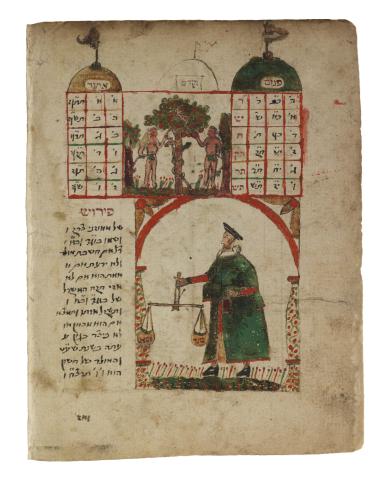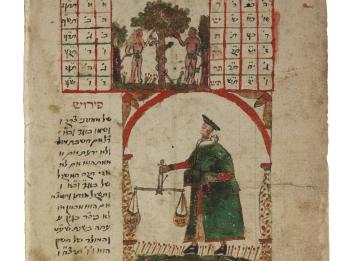Tratado dos Cometas que apareceram em novembro passado de 1618 (Treatise about the Comets That Appeared in November 1618)
Asher bar Samuel ha-Kohen
Leyb ben Samuel Oppenheim
Jacob Rosales
1619
Chapter V: About the Comets That the Ancients Described and Whether Ours Was One of Them
In order to know whether our comet was one of the those that the astrologers described, it is necessary to mention them all here. Compiling as much as his ancestors wrote about comets, Pliny says that there is the Pagonias comet, meaning bearded; it appears to have a wide beard along its lower part. And the Acontias comet, shaped like a dart or a halcyon, and the Xiphias comet, shaped like a sword. These are yellower than the others; they shine and glimmer like a well-polished sword, but do not twinkle. And the Disceus comet, shaped like a golden-colored plate somewhat mixed with silver; this one twinkles, leaving a ray of borders. And the Pithetes comet, shaped like a cube with a smoke-like light emanating from its concavity. And the Ceratias comet, shaped like a gnarled horn. And the Lampades comet, which are like lamps or flaming torches. And the Hippeus comet, which has horse-like manes, closely gathered in a round shape. And a white comet with silver-colored hair or mane; it shines brightly, with the face of a man of great majesty. And flying comets completely encircled with horse-like manes. Albumazar says (setting aside comets that cause eclipses of the sun and moon, since they are dominated by Mars or Mercury) that when the three superior planets—Saturn, Jupiter, and Mars—are in their exaltation and are joined bodily either by square or triangular sextile rays, or contrarily [in their fall], commonly make comets, of which there are many kinds. Being powerful in the great smoke-filled ones, in the dark ones, or in the bright ones, the sun causes comets in the air to be round, white, and tailless. And, thus, there are nine types of comets:
- If the comets are formed during the moon’s exaltation, which is the sign of Taurus, or contrarily, Scorpio, a clear, white star with a large mane is formed and it is called Silver.
- When Mercury reaches its exaltation, which is Virgo or, contrarily, Pisces, a small clear blue star with a large tail is formed and is called the Lord of Ascona.
- In Venus’s exaltation, which is Pisces, or, contrarily, Virgo, a very beautiful star is formed and it is called Soldier.
- In the sun’s exaltation, which is Aries, or, contrarily, Lib[ra], a gold-colored star is formed, having a face similar to that of a man and is round and tailless; it is called Rose.
- In Mars’s exaltation, which is Capricorn, or, contrarily, Cancer, a small red star with a tail is formed and lifted upward, and its head is low; it is called Dawn.
- In Jupiter’s exaltation, which is Cancer, or, contrarily, Capricorn, an upright star over a burning ember is formed; it is called Pole or Column.
- In Saturn’s exaltation, which is Libra, or, contrarily, Aries, a somewhat large tailless star is formed; it is green and black, and is called Black.
- On the Dragon’s head a comet is formed, called Flaming Dragon, and it is shaped like a cattail.
- In the Dragon’s rear or tail, a comet called Roaster is formed, because it looks like a wide spit.
These are the comets that those authors describe and if we compare them to our own, we will find none of them, not even Xiphias, which shines like a sword but does not twinkle, because ours is immense and is not yellow. Thus, none of the aforementioned, not even those made in the air, will we see through its parallax; and the appearance of new signs or comets never seen, because they are new, or events never seen should not be startling. Giovanni Pontano describes a huge comet that was sixty degrees from the heavens and another, fifty degrees in the body of the heavens like ours. And João de Monte Regio describes another horrendous one with a head and a tail, that in twenty-four hours traveled almost four signs from east to west. Seneca (Natural Questions 7:1) says that there was a comet after the death of Demetrius, King of Syria, and shortly before the war of Achaya that was at first fiery and then red with so much light that it turned night into day. And in [Natural Questions] 1:1 he says that, many times he saw a sphere that disappeared during its trajectory. Zonaras, in Vita Constantini, vol. 3, describes a comet as large as the moon. Niceta, in the time of Emperor Alexios Comnenus, says that there was a comet in the heavens that resembled a multicoiled cobra, which, at times, would coil and, at times, would stretch, to the astonishment of humans, whose blood it seemed to thirst for since it did and caused fear. Thus, we must not be frightened by this comet or any of the aforementioned signs that the ancients depict, because God, as the father of mercy, shows us different signs and comets to correct us and make us repent of our sins unless we wish to experience their consequences.
Translated by
.
Other works by Rosales: Status astrologicus sive anacephaleoses da monarchia Lusitana (1624); Luz pequena lunar e estelífera da monarquia Lusitana (1626); Regnum astrorum reformatorum, cujus fundamentum, caelestis astronomiae praxis (1644).
Credits
Manuel Bocarro Francês (i.e. Jacob Rosales), Tratado dos cometas que appareceram em Novembro passado de 1618 (About the Comet that appeared in November 1618) (Lisboa: por Pedro Craesbeeck, 1619), 11–13 (Chapter V: Dos Cometas que os Antigos descreuerao & seo nosso era algum delles (About the Comets that the Ancients described and whether ours was one of them)).
Published in: The Posen Library of Jewish Culture and Civilization, vol. 5.





